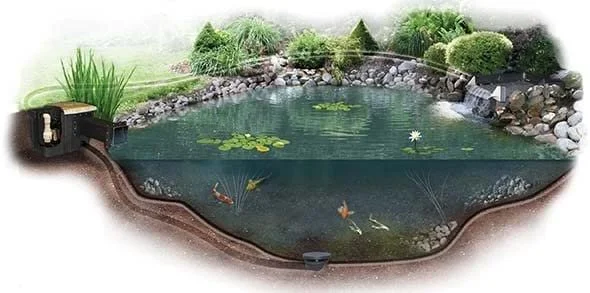Before adding a water garden to your landscape, sit down and have a long talk with yourself.
Ask yourself why you want a water garden: Do you want goldfish or koi? Or do you just want a water garden with plants and no fish? Do you want to hear the water rushing?
Fish dine on mosquitoes and adding a few fish to a water garden wil keep the mosquito larvae population down. It's a misconception that water gardens bring in more mosquitos, because the water is moving and the fish are dining.
Select a site you can enjoy from outside and inside your home. It should be elevated to avoid runoff into your pond. Runoff can introduce sediments, fertilizers and pesticides.
And don't place a water garden too close to trees. If you build under trees, you'll have leaves in your pond. When they rot, they produce fertilizer that can turn your water green.
Next, determine the size pond you want and the type of liner. Most homeowners tend to buy preformed liners, but a Permalon or EPDM rubber liners will allow you to truly design the pond in the shape you want.
Don't try to save money by buying roofing material or a swimming pool liner to use as a water garden liner. These materials contain chemicals that can kill your fish. And a blue pool liner will reflect light, and light encourages algae growth.
Use a garden hose to outline the pond's shape, then a shovel to cut out the design. Till the soil, then finish digging the pond.
Most ponds can be dug by hand. Just make sure you dig the pond at least 24 inches deep and that you leave a 1-foot shelf around the pond. This is where you'll set your potted plants. For larger ponds, rent a backhoe.
Line the bottom with 2 inches of sand to protect the liner from underlying rocks. To see how much liner you need, measure the pond length, width and depth and add 1 to 2 feet. This will give you enough liner to lay in the hole and spread over the edges. Don't try to skimp on liner. It's better to have some left over than not enough.
Anchor your pond liner with rocks. This secures the liner and serves as camouflage. Native rocks make the pond look natural, but don't bother collecting them yourself; it's a lot easier to buy rocks.
Placing small rocks around the edges will hold bacteria and create a biological filter. Leave the bottom of the pond free of rocks to make it easier to clean.
Blend your pond into the existing landscape by planting around the edges. Select plants that hang over the edges and create a natural look.
The final additions to any pond are the most important: a pump and a filter system. Visit several pond suppliers before buying. look for opportunities to see what's available in action. When it comes to pumps, always buy a bigger pump than you think you need.


